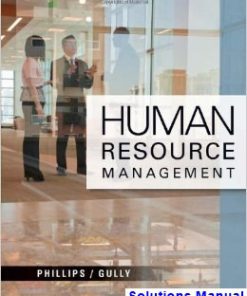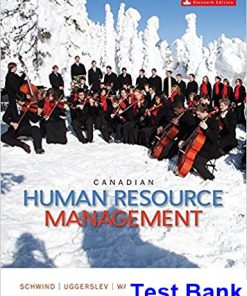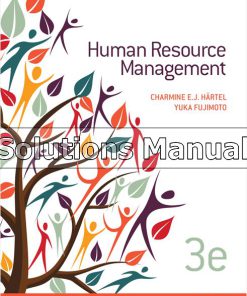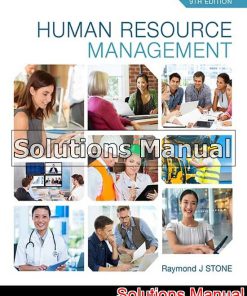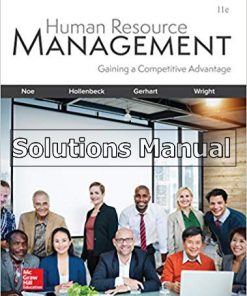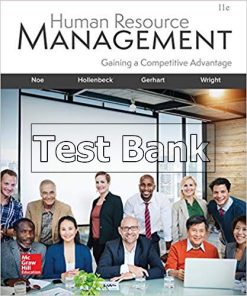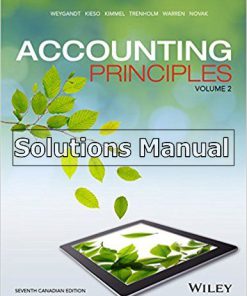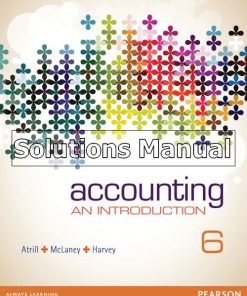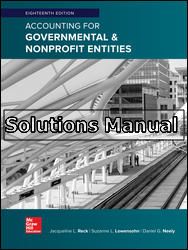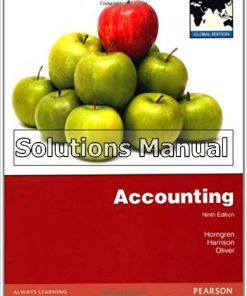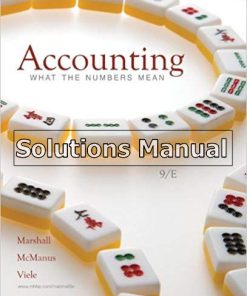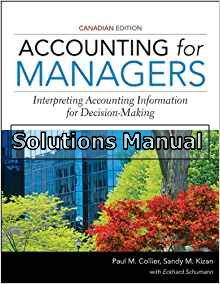Human Resource Management 11th Edition Rue Solutions Manual
You may also like
Human Resource Management 11th Edition Rue Solutions Manual
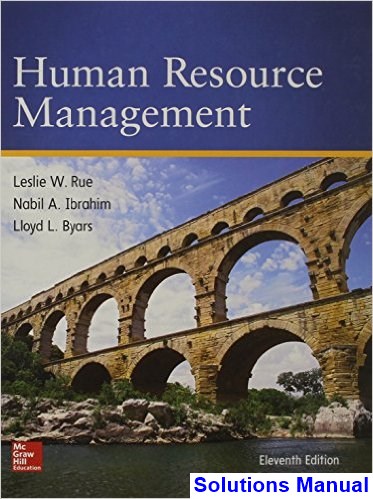
Product details:
- ISBN-10 : 1260098559
- ISBN-13 : 978-1260098556
- Author: John R. Hollenbeck
Human Resource Management: Gaining a Competitive Advantage was developed to teach students how to strategically overcome challenges within organizations and gain a competitive advantage for their companies. All of the authors have won numerous teaching and prestigious research awards; this along with their teamwork and consulting experience delivers a learning program strong is depth and breadth and current in research and practice simply not found in other products.
Table contents:
- PART 1: Human resource management in the modern world
- 1 The nature of human resource management
- Defining human resource management
- The evolution of modern HRM
- HRM and the achievement of organisational effectiveness
- Summary propositions
- General discussion topics
- Theory into practice
- Further reading
- References
- 2 The global context for human resource management
- Defining globalisation
- The causes of globalisation
- The impact of globalisation
- Conclusions
- Summary propositions
- General discussion topics
- Theory into practice
- Further reading
- References
- 3 HRM around the world
- Global HRM: similarities
- Global HRM: differences
- Explaining global diversity in HRM practice
- Is greater divergence a possibility?
- Summary propositions
- General discussion topics
- Theory into practice
- Further reading
- References
- 4 Strategic human resource management
- Strategic HRM
- The relationship between business strategy and HR strategy
- Theoretical perspectives of strategic HRM
- Summary propositions
- General discussion topics
- Theory into practice
- Further reading
- Web link
- References
- 5 Workforce planning, analytics and AI
- The contribution and feasibility of workforce planning
- The scope of workforce planning
- Analysing the environment
- Forecasting future HR needs
- Analysing the current situation and projecting forward
- Reconciliation, decisions and plans
- Workforce analytics and AI (artificial intelligence)
- Summary propositions
- General discussion topics
- Theory into practice
- Further reading
- References
- 6 Employability: the basic skills
- 6.a. Being effective with people
- Summary propositions
- General discussion topics
- Putting it into practice
- 6.b. Using and interpreting basic analytics
- Summary propositions
- General discussion topics
- Putting it into practice
- 6.c. Effective writing
- Summary propositions
- General discussion topics
- Putting it into practice
- 6.d. Presentation
- Summary propositions
- General discussion topics
- Putting it into practice
- Further reading
- References
- PART 2: Resourcing: getting people in the right places to do the right things
- 7 Organisational agility and flexibility
- Organisation design
- Organisation structures
- Employer flexibility
- Employee flexibility
- Summary propositions
- General discussion topics
- Theory into practice
- Further reading
- References
- 8 Recruitment
- Determining requirements
- Rational versus processual approaches to recruitment
- Internal recruitment
- External recruitment
- Recruitment advertising
- Evaluation of recruitment activity
- Summary propositions
- General discussion topics
- Theory into practice
- Further reading
- References
- 9 Selection methods and decisions
- Rational versus processual approaches to selection
- Selection criteria
- Shortlisting
- Selection methods
- Advanced methods of selection
- Final selection decision making
- Validation of selection procedures
- Summary propositions
- General discussion topics
- Theory into practice
- Further reading
- References
- 10 Employability: skills in resourcing
- 10.a. Determining the vacancy
- Summary propositions
- Putting it into practice
- 10.b. Job and competency analysis
- Summary propositions
- Putting it into practice
- 10.c. The selection interview
- Summary propositions
- General discussion topics
- Putting it into practice
- Further reading
- Reference
- PART 3: Performance: success through individual and collective achievement
- 11 Employee performance management
- Performance management or performance appraisal?
- Theoretical bases of performance management
- Performance management across national contexts
- Stages in a performance management system
- Performance management: does it improve performance?
- Summary propositions
- General discussion topics
- Theory into practice
- Further reading
- References
- 12 Leadership
- Leadership and management
- What are the traits of (effective) leaders?
- What is the ‘best way to lead’? Leadership styles and behaviours
- Do leaders need different styles for different situations?
- Transformational leadership: do we really need heroes?
- Followership
- Summary propositions
- General discussion topics
- Theory into practice
- Further reading
- References
- 13 Managing attendance and absence
- The national context
- Impact on the organisation
- Process and causes of absence and attendance
- Managing for appropriate attendance
- Summary propositions
- General discussion topics
- Theory into practice
- Further reading
- References
- 14 Engagement and retention
- Defining engagement
- The benefits of employee engagement
- Employee retention
- The impact of labour turnover
- Analysing labour turnover
- Engagement and retention strategies
- Summary propositions
- General discussion topics
- Theory into practice
- Further reading
- References
- 15 Employability: skills in performance
- 15.a. The appraisal interview
- Summary propositions
- General discussion topics
- Putting it into practice
- 15.b. Designing questionnaires
- Putting it into practice
- Further reading
- References
- PART 4: Development
- 16 Organisational change and development
- The nature of change and the role of planned change
- How can organisations be responsive to change?
- Addressing the employee experience of change
- Reconceptualising change
- Organisational development as a specific approach to change
- The evolution and future of OD
- Summary of the HR role in change
- Summary propositions
- General discussion topics
- Theory into practice
- Further reading
- References
- 17 The context of employee learning and development
- The UK national picture and strategy
- UK skills policy and framework
- The learning context
- Summary propositions
- General discussion topics
- Case study
- Further reading
- References
- 18 Learning and development
- Identifying learning and development needs
- Methods of learning and development: Part 1
- Methods of learning and development: Part 2 Focus on digital learning technologies
- Evaluation of training and development
- Summary propositions
- General discussion topics
- Theory into practice
- Further reading
- References
- 19 Talent and career development
- What is talent?
- Identification of talent
- Strategic talent and career development
- Promotion and succession planning
- Developing talent and careers
- How organisations evaluate talent management
- Summary propositions
- General discussion topics
- Theory into practice
- Further reading
- References
- 20 Employability: skills in learning and development
- 20.a. Teaching and learning
- Summary propositions
- Putting it into practice
- 20.b. Coaching
- Summary propositions
- General discussion topics
- Putting it into practice
- Further reading
- References
- PART 5: Employee relations
- 21 Employee voice
- Terminology
- Information sharing
- Team briefing
- Quality circles
- Attitude surveys
- Suggestion schemes
- Consultation
- Co-determination
- Summary propositions
- General discussion topics
- Theory into practice
- Further reading
- References
- 22 The legal framework of work
- A regulatory revolution
- The contract of employment
- Discrimination law
- Unfair dismissal law
- Health and safety law
- Family-friendly employment law
- Is employment law a benefit or a burden for businesses?
- Summary propositions
- General discussion topics
- Theory into practice
- Further reading
- References
- Legal cases
- 23 Diversity and inclusion
- How ‘equal’ is the workforce?
- Different approaches to equality
- Implications for organisations
- Summary propositions
- General discussion topics
- Theory into practice
- Further reading
- References
- 24 Employability: skills in employee relations
- 24.a. Mediation
- Summary propositions
- General discussion topics
- 24.b. The disciplinary or grievance interview
- Summary propositions
- General discussion topics
- Putting it into practice
- Further reading
- References
- PART 6: Reward: the contract for payment
- 25 Total reward and setting pay
- Introducing reward management
- Total reward
- The elements of payment
- Setting base pay
- The importance of equity
- Regulatory restrictions
- Minimum wages
- Equal pay law
- Unlawful deductions
- International diversity in reward management
- Summary propositions
- General discussion topics
- Theory into practice
- Further reading
- References
- 26 Incentives
- Basic choices
- The extent to which incentives are paid
- Payment by results (PBR) schemes
- Performance-related pay (PRP)
- Skills-based pay
- Profit sharing
- Summary propositions
- General discussion topics
- Theory into practice
- Further reading
- References
- 27 Pensions and benefits
- Pensions
- Occupational pensions and HRM
- Sick pay
- Company cars
- Flexible benefits
- Summary propositions
- General discussion topics
- Theory into practice
- Further reading
- References
- 28 Employability: skills in reward
- 28.a. Negotiation
- Summary propositions
- General discussion topics
- Putting it into practice
- 28.b. How to reward employees working overseas for the dislocation of their domestic and social arra
- Summary propositions
- General discussion topics
- Putting it into practice
- Further reading
- PART 7: Contemporary issues
- 29 HRM and business ethics
- What do we mean by ethics?
- Early management concern with ethics
- Business ethics today
- Ethics and HRM
- Ethics across national boundaries
- Some current and developing ethical dilemmas
- Summary propositions
- General discussion topics
- Theory into practice
- Further reading
- References
- 30 Managing the human resource function
- The HR function: purpose, roles and competencies
- Structure of the HR function
- HR strategic contribution
- HR delivery approaches
- HR shared services
- Outsourcing HR
- The role of line managers in HR
- Critique of the changes in the HR function
- Summary propositions
- General discussion topics
- Theory into practice
- Further reading
- References
- 31 HR in small and medium-sized enterprises
- Introduction
- What do we know about working in SMEs?
- The SME context
- How strategic is HR in SMEs?
- What does this mean for HR practice in SMEs?
- Summary propositions
- General discussion topics
- Theory into practice
- Further reading
- References
- 32 Health and well-being
- The nature of health and well-being
- Health and well-being initiatives
- ‘Good work’ and well-being: job design and job quality
- The business case for health and well-being
- Criticisms of health and well-being initiatives
- Summary propositions
- General discussion topics
- Theory into practice
- Further reading
- References
- 33 Managing the international workforce
- Structuring international organisations
- Managing expatriates
- HRM issues in international organisations
- Summary propositions
- General discussion topics
- Theory into practice
- Further reading
- References
- 34 The future of work
- Long-term labour market trends
- Technology and jobs
- Conclusions
- Summary propositions
- General discussion topics
- Theory into practice
- Further reading
- References
- 35 Advanced HR skills
- 35.a. Chairing meetings
- Summary propositions
- Putting it into practice
- 35.b. Presentation at tribunal
- Putting it into practice
- 35.c. Dealing with bullying and harassment at work
- Summary propositions
- General discussion topics
- Putting it into practice
- 35.d. Using consultants
- Summary propositions
- General discussion topics
- References and Further reading
- Index
- Back Cover
People also search:
fundamentals of human resource management 11th edition
human resource management 11th edition
canadian human resource management 11th edition
human resource management 11th edition ebook
human resource management 11th edition nel werner

